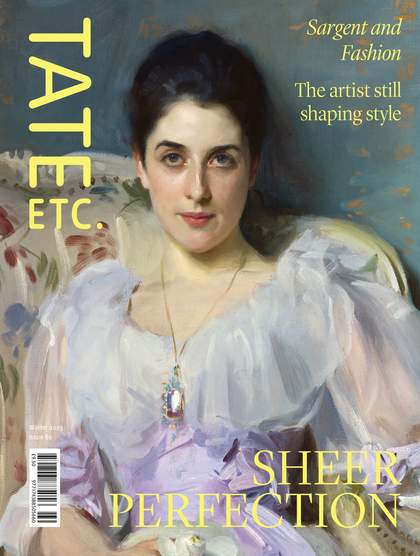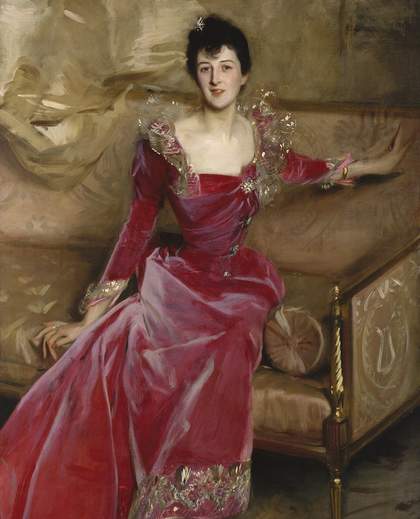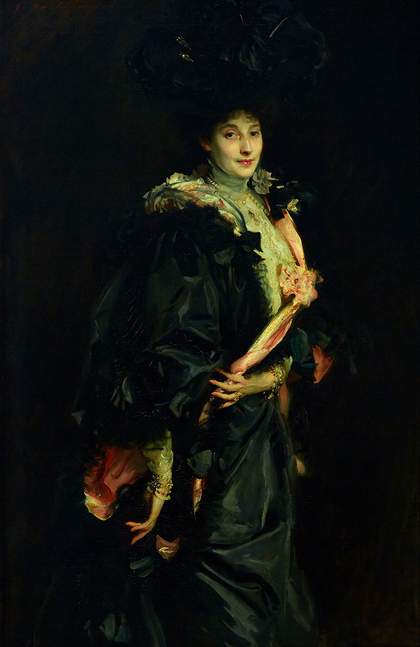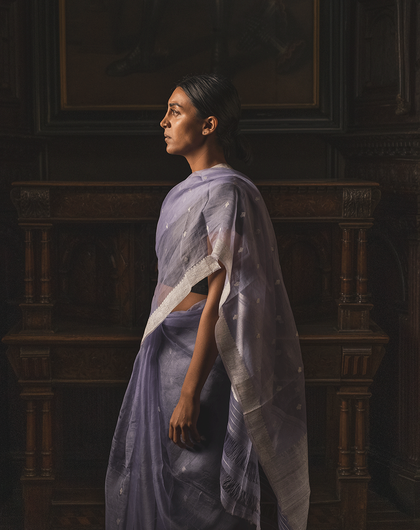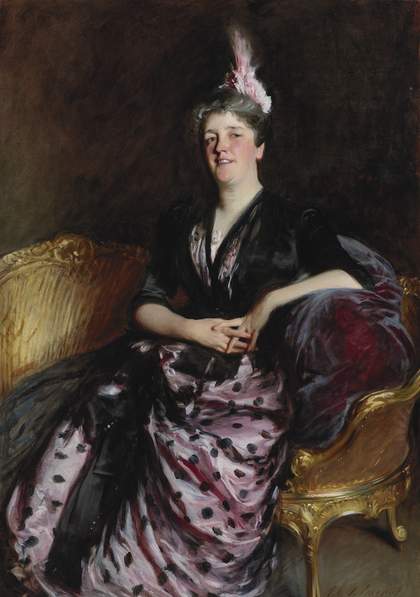
John Singer Sargent
Mrs. Edward Darley Boit (Mary Louisa Cushing) 1887
Photograph © 2023 Museum of Fine Arts, Boston
My dear, quite the most amusing prospect, I am to be painted! A full three-quarters, can you even imagine? And at my age! La Gioconda I am not, though I have been fervently assured by several of my closest friends that Mr Sargent is extremely discerning as to whom he chooses to paint. They say that more than the mere elegance of polite society, he seeks to capture personality. I, for one, find that terribly modern, democratic, a whole new way of doing things – you know he even paints Eton matrons and mystical dancers from Java! His reputation borders on the scandalous, of course, but then one can’t very well expect artists to go on painting like Gainsborough in this age of modern marvels, can one? How preposterous it would be to sit for a painter and have him fashion one’s likeness after an old van Dyck when there are steam trains rattling by and electricity whizzing about above our heads.
I shan’t sit until Spring, but I have already begun my preparations. I’m undertaking the most thorough consideration of figure, toilette, and wardrobe. I have written off to Monsieur Worth and Monsieur Doucet of course, though I’m increasingly concerned that it may be beyond even their significant talents to turn me out something pleasing. I am not the woman I was, and, really, can any known dressmaker provide an antivenom for time? Oh my dear, I feel quite shrivelled. Only last week in Marshall & Snelgrove’s I was mistaken for Florence Nightingale! Naturally, one admires the great lady’s scientific contributions, but my dear, she is 80-something years old. Quite an unsympathetic correspondence.
I’ve told Cook that I shall be banting until Christmas at least, that there are to be no more curries, and only bread and butter for tea. I am, of course, prepared to suffer for Mr Sargent. My dear friend, the novelist Mr James, swears by chewing every mouthful he eats one hundred times. He tells me that it has the most bracing effect on the figure – you may’ve even read one of his books, he is awfully good. Additionally, I have my Goodyear rubberised underdrawers, which help remould the ravages of time and motherhood. All told, I am quietly confident that I shall be able to meet Mr Sargent on his own ground.
Unfortunately, Sir John has yet to be convinced as to the propriety of my sitting for such a portrait. He thinks Mr Sargent’s work in very bad taste, says it’s all divorcées, shop girls and foreigners, and that even the women of good families whom he has persuaded to sit for him come out looking like Trocadero tarts. But that’s my John for you, he’s always been rather less liberal than I when it comes to such things. I cannot help but feel that this is a personal failing on my part, I’ve never yet persuaded him to read so much as a single page of John Stuart Mill in all my years of trying. Davis is, however, quite sure that he’ll come around – she says it’s only a question of, ‘a gentleman’s high-minded concerns’, and no cause for distress. Dear Davis, she has such queer intuition for this sort of thing, born under the sign of the fish, you know?
I intend to hang the picture over the fireplace in the house on Portman Square so that my children’s children’s children, if God so blesses me, will one day look up and ask, ‘I wonder what she was really like, dear Great-grandmama? She has the most mischievous grin.’ I see a little blond girl in pinafore piping up, ‘Was she awfully wise and brave, papa? Tell us she was!’ I have no doubt that my grandson will answer, ‘Oh most wise and most brave, yes, indubitably! But also, quite the troublemaker. Why, she bedevilled dear Great-grandpapa over this very picture, insisting upon it so. He was in a brown study from Whitsun to Michaelmas!’
Naturally Sir John baulks at the price and says that I’m merely showing off, trying to position myself as one of the New Women, which is quite ridiculous given that I’ve never even owned a bicycle. And I certainly never wore my skirts above the ankle before the Empress Elisabeth set it as the fashion. Believe me, my dear, I am not any kind of radical! Of course, I’ve long advocated for the emancipation of women and slaves, but I should say that it’s only common decency to press for the freedom of one’s fellow man. (Though one does wonder; how full can liberty ever be if one is not the architect of one’s own freedom?) It is hard to place oneself in history, is it not?
Perhaps this is why I am drawn so to Mr Sargent, because he represents a new sort of independence? A personal sense of freedom. One does so very much admire that about Americans, their new-sprung sovereignty. And they aren’t all parvenus and dollar princesses, you know; not at all, they have some very fine writers. Perhaps you may have read Mr Whitman, or the late Miss Dickinson yourself ?
Davis asks if I’ve given any thought to having my old silk-satin restyled; it’s a most dreadfully antiquated style now but still such a charming colour. It may well appeal to Mr Sargent – people do say that he has the most eccentric eye. Apparently he has wants to wrap pearls around the waists of his subjects and will often drape them in the drawing room curtains. He will merrily pin a gown into the most outlandish of shapes if the notion takes him, practically hacks off the superfluous sleeves, they tell me, quite redesigns whole gowns so that one hardly need go to Paris!
My dear friend Mrs Iselin offered him 15 fine evening dresses and he rejected them all, insisting that she sit for him in the very same thing she arrived in! Immortalised in full sleeves and a day dress, I’m not sure she’ll ever get over it. She does look rather dour in the picture, but far better stern than comic, I say. I think I’d expire in a puff of smoke if my portrait turned out like Mrs Boit’s! Thirty sittings only for The Times to call her ‘saucy.’ Oh my dear, the humiliation of it all. Is this what I am setting myself up for?
What if he has me pose in lemon-yellow taffeta in the middle of Hyde Park? Or if he presses me to dress in the style of Mary Tudor with all of my late mother’s jewellery pinned about my head? I should never be able to look Mrs Benson in the eye again. I should have to take the picture home immediately and leave it to face the wall until the style became fashionable.
Of course, Sir John says I really oughtn’t to worry, that Mr Sargent’s paintings are such childish daubings, without any real detailing, that nobody will ever know who it is that he has painted anyway. He says that, with half of them, one can hardly tell if the subject is a man or a woman. He says Sargent is an invert himself, but my dear, I can’t believe that to be true. Mr Sargent strikes me as a most sober gentleman; there isn’t a hint of effeminacy to him, one could hardly tell him apart from one’s banker. Besides, they do say that even Michelangelo enjoyed the company of young men, Caravaggio too. As you well know, my dear, artists operate in quite a different mode.
For his part, Mr Sargent sees beyond the world of tawdry materialism, he has insight which one can only think of as Transcendental. His material is one’s very psychology, one cannot think of his artwork as a mere looking glass offered to flatter. You remember, of course, when Lady Sassoon unveiled her own picture? The immediate evaluation was that, in that ludicrous, pink-trimmed opera cloak of hers, she resembled nothing more than a rapacious cunt, and you, my dear, said something to the effect of, ‘Such accuracy.’ Mr Sargent sees within and paints!
Perhaps I may flatter myself then, and admit that I am indeed in possession still, of a little of that which made me sparkle so brilliantly at The Queen Charlotte’s Ball of 1858? One feels that it may well be this particular quality that has attracted Mr Sargent’s attention. One’s inner luminosity, one’s very pneuma, and who could deny a thousand guineas to a man of such perspicacity? Of course, one only hopes, once the picture is unveiled, that the crowds gathered will have the intelligence and sensitivity to see what it is that Mr Sargent is offering them. Not that I have any degree of certainty it will be so. In this world of publicity hounds and moral hypocrisy the reaction could be most adverse. One may well have to retire to the country permanently and live under an assumed name! Ah, but ever was it thus for the muse, my dear. You know how people can be.
Sargent and Fashion, 22 February – 7 July 2024.
Lauren John Joseph is a writer who lives between London and Lancashire. Her novel At Certain Points We Touch is published by Bloomsbury.

